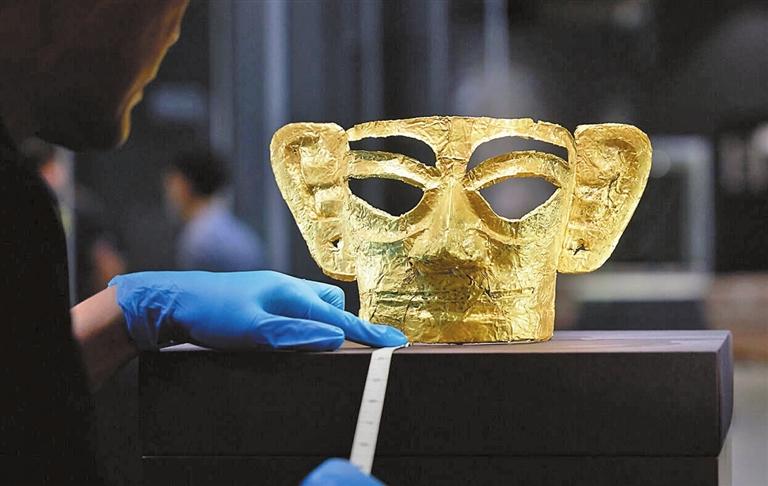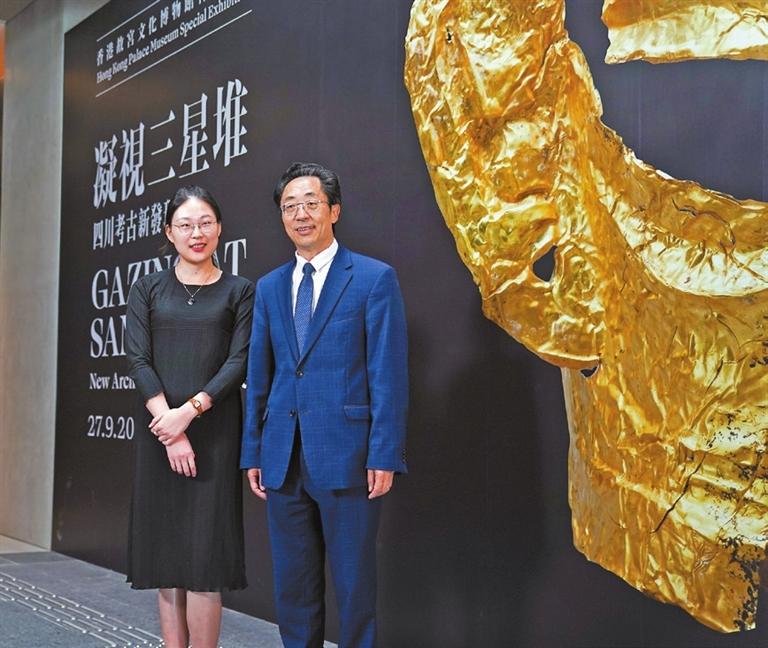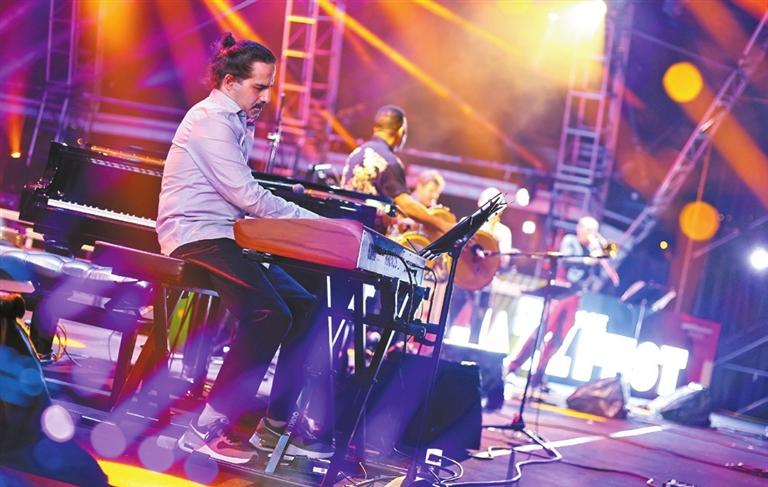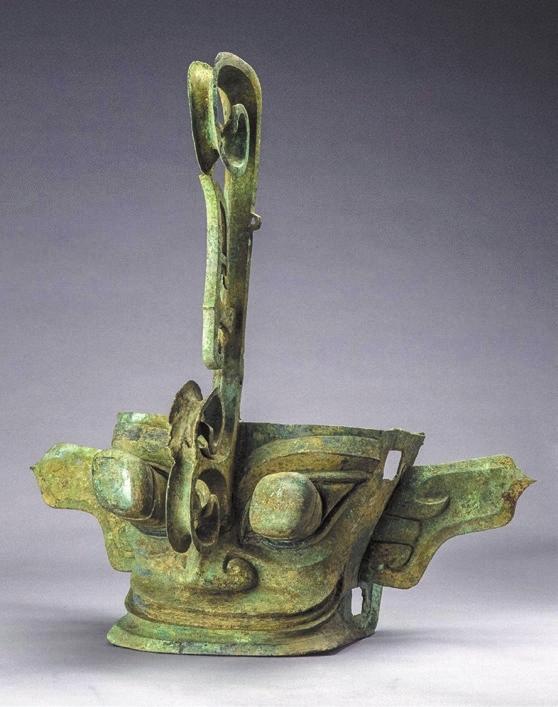




Wang Haolan Holly_cn@163.com THE West Kowloon Cultural District in Hong Kong, a rising cultural landmark and a sought-after holiday destination in the Guangdong-Hong Kong-Macao Greater Bay Area (GBA), welcomes history and art enthusiasts from around the world to immerse themselves in a diverse array of exhibitions, art performances and music festivals scheduled to run until mid 2024. ‘Gazing at Sanxingdui’ The highly anticipated “Gazing at Sanxingdui: New Archaeological Discoveries in Sichuan” (hereafter referred to as “Gazing at Sanxingdui”) special exhibition is set to open its doors to the public at Gallery 8 of Hong Kong Palace Museum (HKPM) in the cultural district Sept. 27. The exhibition, running through Jan. 8, 2024, will showcase 120 artifacts drawn from the archaeological discoveries of three major sites of the ancient Shu Civilization in Sichuan Province, namely, Sanxingdui, Jinsha and Baodun sites. Among these artifacts, 23 pieces hold the distinction of being designated as China’s Grade One Cultural Relics. “Nearly half of the artifacts come from the sites’ most recent archaeological discoveries,” Dr. Tianlong Jiao, head curator of HKPM, said at a news briefing session of the exhibition Wednesday. “This marks the first occasion on which these treasures will be showcased outside of Sichuan Province and the Chinese mainland.” Exhibit highlights will include a gold mask, a bronze mask with the civilization’s protruding pupils, a bronze statue of a mythical creature resembling a pig-nosed dragon and a kneeling figure with a twisted head. All of the artifacts were excavated from the site after 2021. The Sanxingdui site, situated on the southern bank of Yazi River in the city of Guanghan in Sichuan Province, was initially discovered in 1929 and subsequently excavated for the first time in 1934 by an archaeological team from West China Union University. A more comprehensive excavation effort was conducted at the site in the 1980s, leading to the discovery of two sacrificial pits containing over a thousand bronze, ivory, gold and jade artifacts that were believed to have been created during the Sanxingdui Civilization, which flourished around 1800 B.C., as well as remnants of the city of Sanxingdui, which was part of the ancient Shu Kingdom. In another excavation project from March 2020 to June 2022, another six sacrificial pits containing more than 13,000 artifacts have been discovered. “We have imbued the word ‘gazing’ with multiple meanings,” Jiao explained. “It can be associated with the protruding eyes of the masks, which symbolize Can Cong, the first king of the Shu Kingdom. It can also represent a retrospective examination spanning roughly a century of excavation, research and conservation efforts at the Sanxingdui site. Furthermore, it serves to explain Sanxingdui’s history and culture to the audience through an archaeological perspective, enabling them to grasp what life might have been like in the ancient cities of the Shu Kingdom.” Jiao emphasized the significance of incorporating artifacts from Jinsha, a representative site of the Shu Civilization that emerged after Sanxingdui around 1200 B.C., as well as Baodun, an ancient site dating back to approximately 2550 B.C. and believed to be the inaugural capital of the Shu Kingdom. This inclusion aims to help visitors understand the whence and whither of the Sanxingdui Civilization, ultimately enhancing the narrative and completeness of the exhibition. The exhibition will have four sections to elaborate on the multifaceted Sanxingdui Civilization, as outlined by Dr. Shengyu Wang, assistant curator of HKPM: the symbolic depictions of eyes in artifacts such as masks, statues and figurines, the restoration of urban landscape and daily life scenes, an exploration of religious activities, and an investigation into the civilization’s origins and enduring legacy. Wang mentioned that auto-stereoscopic 3D, multimedia installations, holographic projection and other new technologies will be applied to reconstruct the life scenes and religious rituals at Sanxingdui, to restore the original appearance of exhibits and to showcase the artifacts that can’t make it to the exhibition, such as a 3.96-meter-tall bronze tree excavated from one of the sacrificial pits in 1986. “We hope that this exhibition will appeal to visitors from Hong Kong, from the GBA, from the mainland and abroad, and help deepen their understanding of the development of the Chinese civilization,” Dr. Louis Ng, museum director of HKPM, said. “HKPM will keep delving into the origin and achievements of ancient civilizations in China through holding more special exhibitions in the future.” This exhibition is co-organized by HKPM, the Sanxingdui Museum and the Jinsha Site Museum, with support from the Sichuan Provincial Institute of Cultural Relics and Archaeology and the Chengdu Institute of Cultural Relics and Archaeology. It is sponsored by Bank of China (Hong Kong). Tickets for the special exhibition will be priced at HK$150 (US$19.76) for adults and HK$75 for concessions. Ticket holders will also have access to HKPM’s permanent exhibitions at Galleries 1-7 and the ongoing special exhibition at Gallery 9. Performing Arts Season After visiting the treasures of Sanxingdui, why not wrap up your day with a vibrant arts performance in West Kowloon? The cultural district has recently launched its Performing Arts Seasons 2023-2024, offering a diverse lineup of over 80 programs and 700 performances spanning Xiqu (traditional Chinese opera), music, dance and theater. Running until next June, this arts season will showcase several standout programs. These include the Beijing opera performance “Birthday Celebration by Five Daughters,” presented by the China National Peking Opera Company, and a series of three performances by an art troupe consisting of Plum Blossom Award winners from the China Theater Association. These events celebrate the fifth anniversary of the cultural district’s Xiqu Center. Additionally, the WestK Presents: Freespace Jazz Fest will gather over 500 musicians from 11 countries and regions, including American jazz star Stacey Kent and Grammy-winning jazz musician Antonio Sánchez. The season will also feature the Asian premiere of “Elements of Freestyle,” a choreographic fusion of street dance and extreme urban sports presented by the Dutch dance troupe ISH Dance Collective; the return of “The impossible Trail,” an original musical which pocketed 10 awards at the 31st Hong Kong Drama Awards; and the premier of “Hard Times,” an experimental stage drama directed by renowned playwright Edward Lam. Visitors can check the official website of West Kowloon Cultural District for the dates, venues and ticketing information of the performances. | 
